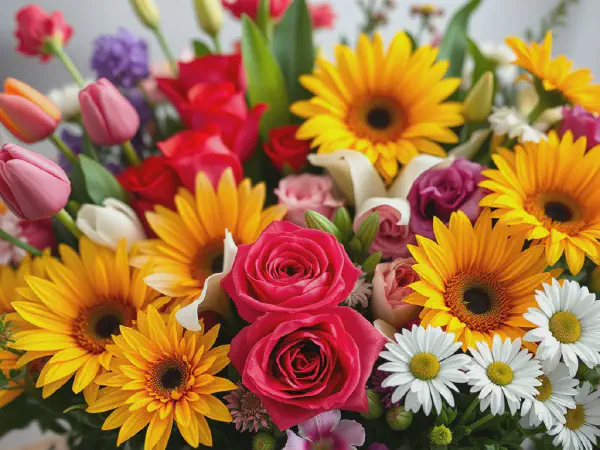Explore the Different Types of Flowers for Every Occasion

A Comprehensive Guide to Types of Flowers
Flowers are the reproductive structures of flowering plants and come in a myriad of shapes, sizes, and colors. Understanding the types of flowers can enhance your appreciation for gardening, floral arrangements, and even nature walks. The terms used to categorize flowers can refer to their physical qualities, growth habits, or the seasons they bloom in. This article will explore various types of flowers, from common varieties to exotic species, seasonal blooms, and gardening techniques.
The beauty of flowers lies not just in their colors and shapes but also in their diverse functions in nature and human culture. Flowers play crucial roles in ecosystems as well as in human life, providing aesthetic value, attracting pollinators, and even serving culinary and medicinal purposes. Knowing the different types of flowers can inspire your gardening and enhance your approach toward flower arrangements and decorations. In this guide, we will dive into everything you need to know about types of flowers.
From classic flowers like roses and tulips to exotic varieties like orchids and hibiscus, flowers bring color and life to our surroundings. There are multiple ways to classify flowers, such as seasonal blooms, types by color, and by their growth characteristics. Additionally, learning about flowers that are edible or possess medicinal properties can enrich our knowledge of gardening and nature. This article is structured to provide you with insights on various types of flowers, seasonal blooms, exotic varieties, and tips for flower arrangements and cultivation.
As we explore the world of flowers, it's important to understand their symbolism and cultural significance. Each type of flower carries meanings and associations that can convey feelings, celebrate milestones, or reflect individual personalities. Whether you are a seasoned gardener or just an admirer of nature's beauty, this comprehensive guide to types of flowers will equip you with knowledge and inspiration for your floral endeavors. Now, let us delve deeper into the various categories of flowers and the wonders they bring.
In summary, flowers are not merely for decoration; they represent a wider range of cultural, aesthetic, and ecological aspects. Understanding the types of flowers invites us to appreciate their beauty further and to use them in various contexts, from gardens to floral arrangements. Join me as we explore the fascinating realm of flowers and learn about their diversity and significance.
Common Types of Flowers
Roses are perhaps the most recognized type of flower, renowned for their beauty and aromatic scent. With various species and colors ranging from red to yellow to blue, each rose variety has different meanings, such as love, friendship, or sympathy. Hybrid roses, such as hybrid tea roses, combine beauty and hardiness, making them popular in gardens and floral arrangements.
Tulips are popular spring-blooming flowers that come in a wide array of colors, including red, yellow, pink, and white. They grow in bulb form and are appreciated for their elegant cup shape and versatility. Tulips can create stunning displays in gardens, patios, and flower arrangements, symbolizing perfect love and renewal.
Sunflowers are known for their striking yellow petals and large, round flower heads that can reach impressive heights. These cheerful flowers attract pollinators such as bees and butterflies, making them excellent choices for gardens. Sunflowers require sunlight and regular watering, and they can flourish in various soil types, emphasizing their role in supporting biodiversity.
Lilies are another classic type of flower, commonly associated with purity and refined beauty. They come in various types, such as Asiatic, Oriental, and Trumpet lilies, each with unique colors and fragrances. Lilies are often used in arrangements for both decorative and symbolic purposes, representing various emotions depending on their color.
Daisies are beloved for their charming, simplistic appearance. They possess a distinctive flower structure with a central yellow disc surrounded by white petals, though many variations exist. Daisies symbolize innocence and purity and are often used in freely arranged bouquets and nature-inspired designs due to their easy cultivation and vibrant presence.
Seasonal Flowers
Spring Flowers, such as daffodils and hyacinths, signal the end of winter and welcome the warmer months. These are some of the earliest bloomers, offering vibrant colors and cheering up gardens and landscapes. Spring flowers are essential considerations for your garden layout, allowing for seasonal transitions.
Summer Flowers bring vivid hues and fragrance, making gardens come alive. Sunflowers, zinnias, and cosmos are just a few examples of flowers that thrive in the warm summer months. When choosing summer flowers, consider vibrant colors that enhance outdoor spaces and attract butterflies and hummingbirds.
Autumn Flowers, such as chrysanthemums and asters, embody the warm tones of fall. These flowers are perfect for seasonal displays and arrangements for harvest celebrations. Their colors range from gold to rich burgundy, making them ideal for transitioning gardens and creating depth in floral designs during this cozy season.
Winter Flowers, like winter jasmine and hellebores, provide color and life in the cold months. Although blooming may be scarce in winter, these hardy flowers can thrive in colder temperatures and offer elegance to winter gardens and indoor decorations.
Holiday Flowers, including poinsettias and amaryllis, dominate winter celebrations. Their striking colors and unique shapes make them popular choices for decorations and gifts during festive occasions. Incorporating these holiday flowers into your decor can enhance your seasonal spirit.
Exotic Flower Varieties
Orchids are perhaps one of the most diverse types of flowers, boasting thousands of species and hybrids. They are admired for their unique beauty and long-lasting blooms. Orchids require specific care, such as fitted lighting and humidity levels, which can challenge indoor growers. Their exotic appearance makes them coveted plants in many homes.
Bird of Paradise is renowned for its striking, unique appearance that resembles a bird in flight. This tropical flower requires ample sunlight and can become quite large, flourishing in warm climates. Its bold colors make it a popular choice for dramatic displays and vibrant tropical arrangements.
Hibiscus flowers hold cultural significance in various parts of the world, from Hawaii to Asia. These large, trumpet-shaped flowers come in many colors and symbolize beauty and delicate nature. They thrive in warm climates and are often used in teas and traditional remedies, further enhancing their importance beyond ornamental purposes.
The Lotus flower is not only visually stunning but also symbolizes purity, enlightenment, and rebirth. It grows in water and emerges beautifully, growing in muddy conditions. Lotus flowers are celebrated in various cultures and hold a significant place in religious and spiritual contexts.
Passion Flower is known for its intricate structure and intense beauty. It adapts to growing in various climates and is often associated with passion and spirituality. Its stunning flowers attract pollinators, and parts of the plant are used in herbal remedies, enhancing its versatility in both gardens and wellness.
Flower Arrangement Techniques
Bouquet styles vary greatly and can include structured, freeform, or cascading arrangements. Popular bouquet arrangements often feature a mix of flower types, colors, and textures to create a visually pleasing design. Knowing which types of flowers work well together can elevate your floral designs and personal styles.
Centerpieces generally use various flower types attractive for events or gatherings. Considerations include flower height, color schemes, and depth. Centerpieces can incorporate flowers and greenery to create dynamic and engaging displays on tables and mantles.
Wreath making is a seasonal craft using different flower types and greenery. Seasonal flower picks, such as holly for winter or wildflowers for summer, can enhance a wreath's charm and reflect the beauty of each season.
Floral crowns often use smaller flowers, making the wearer feel special and whimsical. Suitable flowers may include daisies, baby’s breath, or even vibrant blooms. Understanding suitable styles and flower types can create stunning floral crowns for occasions such as weddings and festivals.
Choosing the right flowers for events goes beyond aesthetics; it requires considering the event's theme, the intended message, and the season's appropriateness. Each type of flower possesses unique qualities that can impact the overall ambiance of your gathering, making thoughtful selections essential.
Medicinal and Edible Flowers
Edible flowers such as calendula, nasturtium, and violets add beauty and flavors to culinary creations. They can be used in salads, as garnishes, or infusion in teas. Knowing which flowers are safe to eat is crucial when incorporating them into food.
Medicinal flowers include chamomile and echinacea, known for their healing properties. Often used in herbal remedies, these flowers provide health benefits ranging from soothing stomach issues to enhancing immune function. Understanding which flowers lend their strengths to health can help in holistic practices.
Culinary herbs, such as basil and chives, also produce flowers that enhance flavors. Incorporating flowering herbs in dishes can provide beautiful presentation and unique tastes. Learning how to use these flowering herbs can revolutionize your cooking endeavors.
Preserving flowers for use in herbal remedies requires specific drying or infusing techniques to maintain their beneficial properties. Tips for drying, storing, and using flowers in remedies can amplify their advantages in holistic health practices.
Winter savory is a notable herb with flowering capabilities, providing culinary flavor in winter dishes. Its flowers attract pollinators, making it an appealing choice for herb gardens and biodiversity, showcasing the versatility of edible flowers throughout the seasons.
Cultivating Flower Gardens
Choosing flower types for your garden involves considering climate, soil conditions, and available sunlight. Selecting flowers that suit your garden's environment and your personal preferences can enhance your gardening experience and ensure plant success.
Best flower types for pollinator gardens focus on attracting bees, butterflies, and hummingbirds. By incorporating native flowers into your garden, you promote biodiversity and contribute to the broader ecosystem while creating a vibrant, lively environment.
Companion planting with flowers can improve garden yield and health. Pairing flowers with vegetables or herbs can deter pests and promote growth, as well as enhancing the aesthetic appeal of your garden space.
Organic gardening emphasizes using natural methods for cultivating flowers, promoting biodiversity and soil health. Choosing organic flower types can benefit pollinators while ensuring a healthy, eco-friendly garden environment.
Flowering shrubs provide long-lasting beauty to gardens and landscapes, adding structure and seasonal interest. Types such as hydrangeas and azaleas yield stunning blooms and contribute to a diverse plant community, enhancing the overall garden aesthetic.
